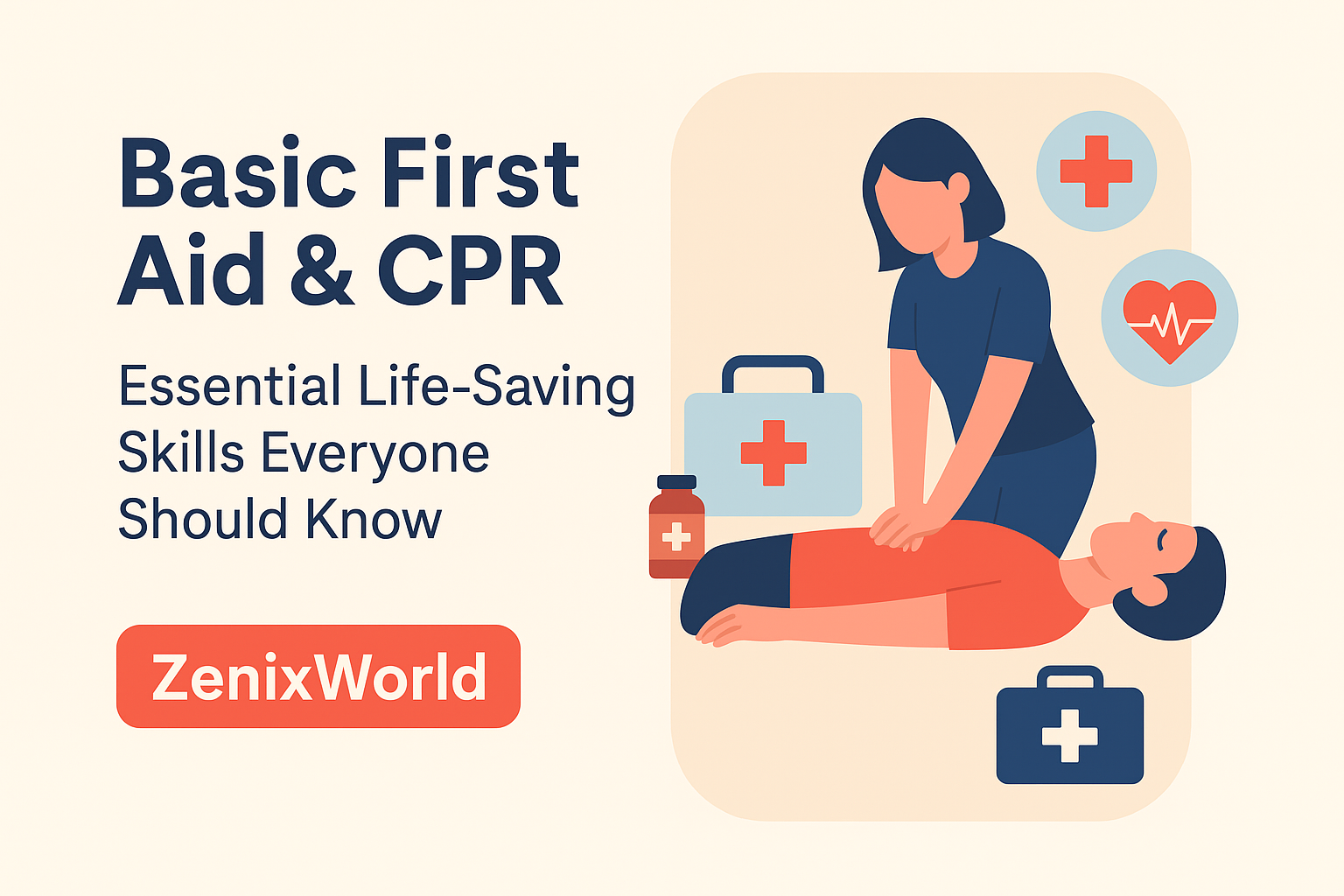💬 Introduction
Emergencies can happen anywhere — at home, on the road, or at work — and sometimes every second counts. Knowing Basic First Aid and CPR (Cardiopulmonary Resuscitation) can mean the difference between life and death.
At ZenixWorld, we believe that learning these simple, hands-on skills is part of everyday wellness — because taking care of others is also taking care of yourself.
In this guide, you’ll learn the core steps of first aid and CPR, how to stay calm during emergencies, and what to do before medical help arrives.
🚑 What Is First Aid?
First Aid is the immediate care you give to someone who’s injured or suddenly ill before professional help arrives.
The goal of first aid is simple:
- Preserve life
- Prevent the condition from worsening
- Promote recovery
You don’t have to be a doctor to help — just a calm, informed person with the right knowledge and quick reaction.
🧠 The ABCs of First Aid
Every emergency situation should be approached using the ABC principle:
- A – Airway: Make sure the person’s airway is clear.
- B – Breathing: Check if they are breathing normally.
- C – Circulation: Ensure their heart is beating and blood is circulating.
If any of these are missing, immediate CPR or first aid action is needed.
💓 Understanding CPR (Cardiopulmonary Resuscitation)
CPR is a life-saving technique used when someone’s heart stops beating or they stop breathing. It keeps oxygen flowing to the brain and vital organs until medical help arrives.
🧩 When to Perform CPR
Start CPR immediately if someone:
- Is unresponsive
- Is not breathing normally (gasping or no breathing)
- Has no pulse
🫁 Steps for Adult CPR (Hands-Only CPR)
If you’re not trained or hesitant, Hands-Only CPR is effective and easy to remember:
- Call for help.
Dial your local emergency number Click here to get emergency number. - Position your hands.
Place the heel of one hand on the center of the chest, then place your other hand on top. - Push hard and fast.
- Depth: About 2 inches (5 cm) deep
- Speed: 100–120 compressions per minute
- Think: “Stayin’ Alive” beat 🎵
- Let the chest rise fully between pushes.
Continue until medical help arrives or the person starts breathing.
🧒 For Children and Infants
- For children: Use one hand instead of two.
- For infants: Use two fingers in the center of the chest, pressing about 1.5 inches (4 cm).
- Give gentle breaths if trained to do so.
🩹 Common First Aid Situations & How to Handle Them
1. Bleeding or Cuts
- Apply pressure using a clean cloth or bandage.
- Keep pressing until bleeding stops.
- Do not remove deep-embedded objects — stabilize them instead.
2. Burns
- Cool the burn under running water for at least 10–15 minutes.
- Do not apply ice or toothpaste.
- Cover with a clean, non-stick cloth.
3. Choking
- Ask: “Are you choking?”
- If they can’t talk or breathe, perform the Heimlich maneuver:
- Stand behind the person.
- Make a fist and place it just above their navel.
- Thrust inward and upward until the object comes out.
4. Fractures & Sprains
- Immobilize the affected limb using a splint or support.
- Apply a cold compress to reduce swelling.
- Avoid moving the person unnecessarily.
5. Fainting
- Lay the person flat and elevate their legs.
- Loosen tight clothing.
- Keep them comfortable and monitor breathing.
🧰 Your Personal First Aid Kit Checklist
A good first aid kit can save precious time during emergencies.
Keep one at home, in your car, and at work.
Essentials:
- Sterile gauze & adhesive bandages
- Antiseptic wipes or solution
- Pain relievers (paracetamol, ibuprofen)
- Disposable gloves
- Medical tape & scissors
- CPR face shield or mask
- Thermometer
- Burn ointment & cold pack
🧠 Stay Calm: The Most Important First Aid Skill
Panic is your worst enemy during an emergency.
Remember these three golden rules:
- Stay calm – Breathe deeply and think clearly.
- Check safety – Ensure the area is safe for you and the injured person.
- Call for help – Professional assistance should always be contacted early.
The calmer you are, the better you can help.
💡 Why Everyone Should Learn CPR and First Aid
- Emergencies can happen anywhere.
- Immediate help can double or triple survival chances after cardiac arrest.
- First aid knowledge builds confidence and community safety.
- Learning CPR doesn’t just save strangers — it might save a loved one someday.
🌍 First Aid as Part of Wellness
At ZenixWorld, we view health as a complete lifestyle — not just diet and fitness.
Knowing first aid and CPR is part of that lifestyle: it gives you confidence, calmness, and compassion under pressure.
Caring for others’ safety strengthens your mental and emotional wellness, too — it’s the ultimate act of empathy and preparedness.
🏁 Conclusion
Emergencies don’t wait — but preparation gives you power.
By learning Basic First Aid and CPR, you equip yourself with tools that can save lives and protect your loved ones.
Start small: take a certified CPR or first aid course, build your own kit, and keep practicing safety awareness.
Because true wellness isn’t just about living well — it’s about helping others live, too.



